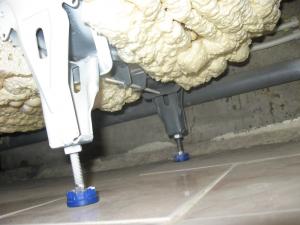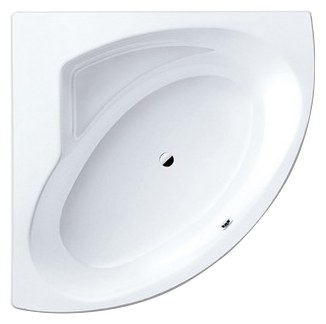.jpg)
Photo: kb-studio.ru
The advantages of steel baths:
- Compared to cast iron, it has become easier to give the desired shape. Due to this, the range of steel baths is much wider and saturated with a large number of ergonomic and convenient models.
- In the process of transportation and installation of such baths are simple compared to cast iron, because they are lighter. The mass of an average steel bath is four to five times less than that of a cast iron one. Reliable steel baths have a weight of 30-50 kilograms, and baths with thin walls weigh less than 30 kilograms.
- Strength and smoothness of enamel. Due to the application of enamel at high temperatures, it does not peel off. Temperature fluctuations can only lead to a slight expansion of the material, without even small cracks.
- Baths from steel are not burdensome in care. In addition, a very self-cleaning steel bath is necessary, because the water begins to collect in drops, while capturing almost all the dirt particles.
- If there is a question - acrylic or steel bath - and the funds allocated for the purchase are limited - choose steel. An inexpensive iron bath from a good manufacturer will last for many years, and an inexpensive acrylic of unknown origin will most likely disappoint.
- Baths of enameled steel are characterized by resistance to the influence of cosmetics and acid resistance. Even burning or smoldering objects (candles or cigarettes) do not leave marks on the enamel surface.
Disadvantages of steel baths:
- Noise.
- These baths do not keep the heat well due to the high thermal conductivity of materials, so the water in them cools very quickly.
- Under heavy loads, the product may be deformed. The thicker the walls, the smaller the deformation. The wall thickness should be at least 3-3.5 millimeters.
IMPORTANT! You should know that all these valid arguments are valid only in relation to steel baths with thin walls with a thickness of 1.5-2.3 millimeters. The walls of such baths are very soon deformed, with enamel cracking, chipping and dents are formed.
- Installing a steel bathroom will require more effort than installing cast iron. A steel bath is easier, and so that it does not "walk" - it must be carefully fixed.
Sound Insulation Steel Bath
The water in the thin-walled fonts cools down in a short time, and when they are filled, they “thunder”. Currently, foreign manufacturers of steel baths get rid of the ring by attaching rubber pads to the walls of the bath, but this does not completely solve the problem.
The company “Kaldewei” as a soundproofing of the baths produces an antiresonant base made of styrofoam (foam-like material). This stand is installed on the ceiling. It is equipped with inspection hatches for the supply line of the mixer and the drain set and is calculated on the tiling.
There are also many “homemade” ways to reduce noise. To do this, columns of foam concrete or brick are placed under the bottom of the steel bath, and the voids that remain between them are sealed with foam, while the bath is pre-filled with water. The joint of the walls and upper edges of the bath is coated with silicone sealant.

Another way is to use vibration-absorbing materials (SGM-vibration) with a self-adhesive surface. You can buy them in the auto shop.
.jpg)
Steel bath selection
When buying a steel bath, try moving the sample. If the product could not be moved, this is a thick-walled model. In the case when a large-sized steel bath (1700x700 millimeters) has a weight of no more than 20 kilograms, this means that its walls are not of sufficient thickness. High quality products are made of steel, whose thickness is 3.5 mm, while their weight is 30-50 kg.
The range of models of steel baths on the market today is quite wide. You can give preference to a “sit” steel bath with colored enamel, a corner bath - it all depends on desires and taste.
The walls of good steel baths have a thickness of 3.5 millimeters, so that they do not ring much. However, due to the cost, Polish / Czech or domestic steel baths having a thickness of 2.3 millimeters are more popular. They are made only standard forms in the form of a trough.
Italian, French, Spanish and Finnish factories make durable baths of steel of convenient shape, having good enamel and almost similar design with a wall thickness of 2.5-3 millimeters. However, most companies provide a guarantee on the safety of the original appearance of enameled steel bath for 15-30 years.
The company “Emalia” (Poland) produces 1.6 mm thick baths, “BLB” (Portugal) - 3-3.5 mm, “Estap” - 2.3 mm, “Gala” (Spain) - 2 mm. In this enamel coating has a thickness of not more than 0.6 millimeters.

Photo: abidor-shop.ru Angle steel bath Kaldewei PUNTA DUO
Accessories and extras
.jpg)
These are wide ergonomic sides on which you can sit down, chrome comfortable handles, armrests, towel bars, encircling the bath, seats - all this is intended to provide maximum comfort to users.
Basically, the baths are available in standard sizes, but those who wish can choose models and non-standard sizes, for example, 1700x900, 2000x1000, 1900x900 millimeters, etc. Standard bath depth varies from 450 to 470 millimeters.
Manufacturers also care about the safety of their customers. That is why special anti-slip anti-slip systems are available for baths. For persons with disabilities and the elderly, baths are recommended in which the bottom is covered with an anti-slip system.
Steel bath cost
Currently, the most popular manufacturers of steel baths: “Roca” (Spain), “Kaldewei” (Germany), “BLB” (Portugal), “Estap” (Slovakia), in Russia - Ltd "VISSteel "(Ekaterinburg) and many others.
European samples of steel economy-class baths cost from 2500-3000 rubles (these are models of the companies “Estap”, “BLB”) to 6000-9000 rubles (products of the company “Kaldewei”). You will have to pay from 10,000 to 55,000 rubles for a steel bath from the category of comfort (original shape, enlarged size, with handrails, angular, and with other additional options).
The cost of models with light therapy or a hydromassage system is much more expensive, they will cost from 30,000 to 80,000 rubles.

